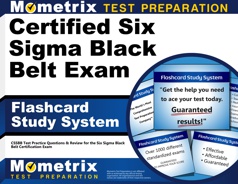
Professionals who have been Six Sigma certified as a Black Belt can explain Six Sigma principles and philosophies, understand team dynamics, demonstrate leadership abilities, and assign team member roles.
Click “Start Test” above to take a free Six Sigma Black Belt practice test!
Those who wish to complete the Black Belt certification must first complete one of the following:
This work experience must be full-time and paid. Internships, co-ops, and/or other coursework may not be substituted.
Since the exam can be taken either by computer or by using pencil and paper, it can be different lengths depending on the version taken.
The computer-delivered exam contains 165 multiple-choice questions, and you are given 4 hours and 18 minutes to finish. Only 150 of these questions are scored; the remaining 15 are unscored and used to evaluate future exam questions.
The paper-and-pencil exam contains 150 multiple-choice questions, and you are given 4 hours to complete it.
The test is broken into 9 major sections:
Check Out Mometrix's Six Sigma Black Belt Study Guide
Get practice questions, video tutorials, and detailed study lessons

Exams are delivered by Prometric at one of their many testing facilities. You can schedule to take it year-round during specific testing windows. Specific dates and times are listed online when you schedule your exam.
A complete list of available testing centers throughout the US will be made available to you during your scheduling. There are international locations available as well.
Once your application has been approved, you will be sent an eligibility letter that will include instructions on how to schedule your exam. The fee to take the certification exam is $538. For members of ASQ the fee is only $438. This includes a non-refundable $70 fee.
Think you aren’t a good test-taker? Maybe on a study-time crunch? Or just don’t know how to begin studying? Mometrix has designed a new Study Secrets course to help every student, no matter what study scenario you are in. Here’s what you’ll find in the Study Secrets Course:
Everyone learns differently, so we’ve tailored our Study Secrets Course to ensure every learner has what they need to prepare for their upcoming exam or semester. Click below to check it out!
There are two ways this exam is given: by computer or using paper and pencil. Most people take the computer version of the exam.
Both versions of this exam are open-book. You may bring your own reference materials to use during the exam. However, each of these items will be inspected upon your arrival at the testing site. Stapled or paper-clipped materials, any unbound notes, tablets, slide charts, or wheel charts are prohibited.
If you are taking the computer-delivered exam, you will not need to bring any other materials with you. A calculator will be provided on the screen for you. Any calculators that are brought with you must be silent, hand-held, and battery-operated without programmable memory.
There is a total of 750 possible points on the certification exam. To pass, you will need a score of at least 550.
Those who are taking the computer-administered exam will receive a score report upon completion at the testing site. This will appear as a pass/fail status. For those who fail, your score report will also include diagnostics on your performance.
You will also be able to access your results online 7-10 business days after your exam date. When your results are available, you will receive an email notification.
Your success on Six Sigma test day depends not only on how many hours you put into preparing but also on whether you prepared the right way. It’s good to check along the way to see whether your studying is paying off. One of the most effective ways to do this is by taking Six Sigma practice tests to evaluate your progress. Practice tests are useful because they show exactly where you need to improve. Every time you take a free Six Sigma Black Belt exam practice test, pay special attention to these three groups of questions:
This will show you exactly what your weak areas are and where you need to devote more study time. Ask yourself why each of these questions gave you trouble. Was it because you didn’t understand the material? Was it because you didn’t remember the vocabulary? Do you need more repetitions on this type of question to build speed and confidence? Dig into those questions and figure out how you can strengthen your weak areas as you go back to review the material.
Additionally, many Six Sigma Black Belt practice tests have a section explaining the answer choices. It can be tempting to read the explanation and think that you now have a good understanding of the concept. However, an explanation likely only covers part of the question’s broader context. Even if the explanation makes sense, go back and investigate every concept related to the question until you’re positive you have a thorough understanding.
As you go along, keep in mind that the Six Sigma practice test is just that: practice. Memorizing these questions and answers will not be very helpful on the actual test because it is unlikely to have any of the same exact questions. If you only know the right answers to the sample questions, you won’t be prepared for the real thing. Study the concepts until you understand them fully, and then you’ll be able to answer any question that shows up on the test.
When you’re ready to start taking practice tests, follow this strategy:
Check Out Mometrix's Six Sigma Black Belt Flashcards
Get complex subjects broken down into easily understandable concepts

There are 165 questions on the computerized version of the Six Sigma Black Belt exam, and there are 150 on the paper-and-pencil version.
The computerized Six Sigma Black Belt exam is timed at 4 hours and 18 minutes, while the paper-and-pencil version is timed at 4 hours.
A passing score on the Six Sigma Black Belt exam is 550.
The Six Sigma Black Belt exam costs $438 for ASQ members and $538 for non-members.

Peter Rench joined Mometrix in 2009 and serves as Vice President of Product Development, responsible for overseeing all new product development and quality improvements. Mr. Rench, a National Merit Scholar, graduated magna cum laude with a Bachelor of Science in Mechanical Engineering and a minor in mathematics from Texas A&M University.
by Mometrix Test Preparation | Last Updated: September 6, 2024